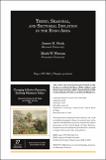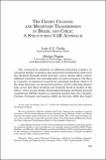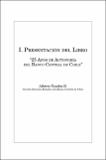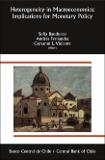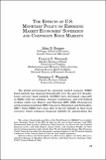Buscar
Mostrando ítems 21-30 de 132
Trend, seasonal, and sectorial inflation in the Euro Area
A central focus of monetary policy is the underlying rate of inflation
that might be expected to prevail over a horizon of one or two years.
Because inflation is estimated from noisy data, the estimation of
this underlying rate of inflation, which we refer to as trend inflation,
requires statistical ...
Fiscal inflation and cosmetic defaults in a small open economy
For a small open economy, maintaining a stable exchange rate and moderate levels of inflation is often a goal of primary importance. At the same time, the profession has recognized the tight link between fiscal and monetary policies in determining inflation dynamics. Thus, the goal of a stable exchange ...
The fiscal footprint of macroprudential policy
Monetary policies leave a fiscal footprint. When the central bank cuts the policy interest rate, this footprint comes through multiple
channels: The demand for currency rises, so the central bank prints more banknotes to accommodate it, and this creates seignorage revenues. Inflation unexpectedly ...
Inflation targeting under political pressure
Historically, many emerging economies, particularly in Latin America, battled against persistently high and volatile inflation. Today, emerging economies continue to experience higher inflation than developed ones, and their central banks deviate more frequently from inflation targets. These patterns ...
The credit channel and monetary transmission in Brazil and Chile: a structured VAR approach
The widespread adoption of inflation-targeting regimes by emerging market economies has generated considerable interest in the channels through which monetary policy shocks affect output inflation and other relevant aggregates in such economies. Yet there is a paucity of empirical research for emerging ...
'25 Años de Autonomía del Banco Central de Chile'
Cuando a mediados de los noventa tomé mis primeros cursos de monetaria la autonomía del Banco Central ya era parte fundamental del paisaje económico de Chile. Para ese entonces como había señalado Roberto Zahler algunos años antes al asumir la presidencia del Banco Central ya se observaba 'entre los ...
Heterogeneity in macroeconomics: implications for monetary policy
There is important heterogeneity among households, firms, and banks; and the way shocks or policies affect these agents depends critically on that heterogeneity. There was a rapid surge in the awareness of academic researchers and policymakers of the nexus between heterogeneity and monetary policy, ...
Estudios monetarios
En portada: Seminario de Mercado de Capitales, con auspicio de la Organización de Estados Americanos (OEA)
The effects of U.S. monetary policy on emerging market economies’ sovereign and corporate bond markets
The global environment for emerging market economy (EME) bond markets has changed dramatically over the past few decades. Local currency bond markets (LCBMs) have developed especially in EMEs with low inflation stronger institutions and well defined creditor rights (see Burger and Warnock 2003 2006 ...
Monetary policy under financial turbulence: an overview
The financial crisis that started in 2007 brought the global economy to the brink and in many respects it is still unfolding especially in Europe. How to understand and deal with the crisis has naturally been the subject of fierce debates that continue today. However some consensus appears to be ...

